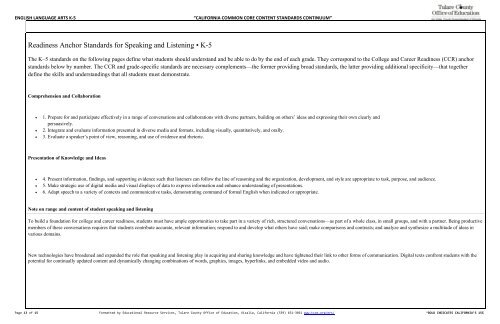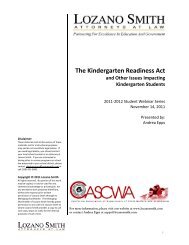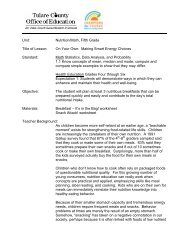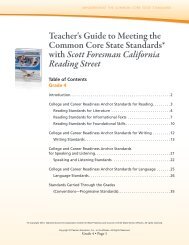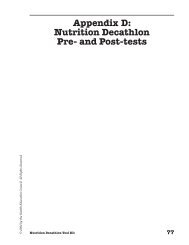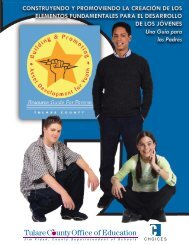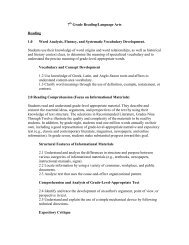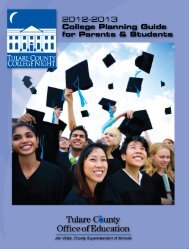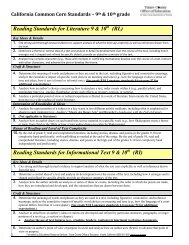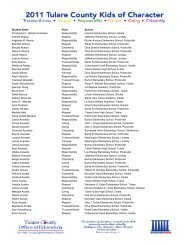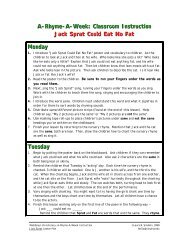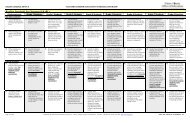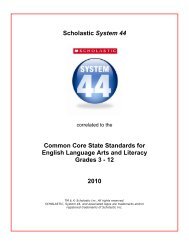ENGLISH LANGUAGE ARTS K‐5 “CALIFORNIA COMMON CORE CONTENT STANDARDS CONTINUUM”College and Career Readiness Anchor Standards for Writing • K-5The K–5 standards on the above pages define what students should understand and be able to do by the end <strong>of</strong> each grade. They correspond to the College and Career Readiness (CCR)anchor standards below by number. The CCR and grade‐specific standards are necessary complements—the former providing broad standards, the latter providing additionalspecificity—that together define the skills and understandings that all students must demonstrate.Text Types and Purposes 11. Write arguments to support claims in an analysis <strong>of</strong> substantive topics or texts, using valid reasoning and relevant and sufficient evidence.2. Write informative/explanatory texts to examine and convey complex ideas and information clearly and accurately through the effective selection, organization, and analysis <strong>of</strong> content.3. Write narratives to develop real or imagined experiences or events using effective technique, well-chosen details, and well-structured event sequences.Production and Distribution <strong>of</strong> Writing4. Produce clear and coherent writing in which the development, organization, and style are appropriate to task, purpose, and audience.5. Develop and strengthen writing as needed by planning, revising, editing, rewriting, or trying a new approach.6. Use technology, including the Internet, to produce and publish writing and to interact and collaborate with others.Research to Build and Present Knowledge7. Conduct short as well as more sustained research projects based on focused questions, demonstrating understanding <strong>of</strong> the subject under investigation.8. Gather relevant information from multiple print and digital sources, assess the credibility and accuracy <strong>of</strong> each source, and integrate the information while avoiding plagiarism.9. Draw evidence from literary or informational texts to support analysis, reflection, and research.Range <strong>of</strong> Writing10. Write routinely over extended time frames (time for research, reflection, and revision) and shorter time frames (a single sitting or a day or two) for a range <strong>of</strong> tasks, purposes, and audiences.Note on range and content in student writingTo build a foundation for college and career readiness, students need to learn to use writing as a way <strong>of</strong> <strong>of</strong>fering and supporting opinions, demonstrating understanding <strong>of</strong> the subjects they are studying, and conveying real andimagined experiences and events. They learn to appreciate that a key purpose <strong>of</strong> writing is to communicate clearly to an external, sometimes unfamiliar audience, and they begin to adapt the form and content <strong>of</strong> their writing toaccomplish a particular task and purpose. They develop the capacity to build knowledge on a subject through research projects and to respond analytically to literary and informational sources. To meet these goals, students mustdevote significant time and effort to writing, producing numerous pieces over short and extended time frames throughout the year.1 These broad types <strong>of</strong> writing include many subgenres. See Appendix A for definitions <strong>of</strong> key writing types.Page 12 <strong>of</strong> 15 Formatted by <strong>Education</strong>al Resource Services, <strong>Tulare</strong> <strong>County</strong> <strong>Office</strong> <strong>of</strong> <strong>Education</strong>, Visalia, California (559) 651‐3031 www.tcoe.org/ers/ *BOLD INDICATES CALIFORNIA’S 15%
ENGLISH LANGUAGE ARTS K‐5 “CALIFORNIA COMMON CORE CONTENT STANDARDS CONTINUUM”Readiness Anchor Standards for Speaking and Listening • K-5The K–5 standards on the following pages define what students should understand and be able to do by the end <strong>of</strong> each grade. They correspond to the College and Career Readiness (CCR) anchorstandards below by number. The CCR and grade-specific standards are necessary complements—the former providing broad standards, the latter providing additional specificity—that togetherdefine the skills and understandings that all students must demonstrate.Comprehension and Collaboration1. Prepare for and participate effectively in a range <strong>of</strong> conversations and collaborations with diverse partners, building on others’ ideas and expressing their own clearly andpersuasively.2. Integrate and evaluate information presented in diverse media and formats, including visually, quantitatively, and orally.3. Evaluate a speaker’s point <strong>of</strong> view, reasoning, and use <strong>of</strong> evidence and rhetoric.Presentation <strong>of</strong> Knowledge and Ideas4. Present information, findings, and supporting evidence such that listeners can follow the line <strong>of</strong> reasoning and the organization, development, and style are appropriate to task, purpose, and audience.5. Make strategic use <strong>of</strong> digital media and visual displays <strong>of</strong> data to express information and enhance understanding <strong>of</strong> presentations.6. Adapt speech to a variety <strong>of</strong> contexts and communicative tasks, demonstrating command <strong>of</strong> formal English when indicated or appropriate.Note on range and content <strong>of</strong> student speaking and listeningTo build a foundation for college and career readiness, students must have ample opportunities to take part in a variety <strong>of</strong> rich, structured conversations—as part <strong>of</strong> a whole class, in small groups, and with a partner. Being productivemembers <strong>of</strong> these conversations requires that students contribute accurate, relevant information; respond to and develop what others have said; make comparisons and contrasts; and analyze and synthesize a multitude <strong>of</strong> ideas invarious domains.New technologies have broadened and expanded the role that speaking and listening play in acquiring and sharing knowledge and have tightened their link to other forms <strong>of</strong> communication. Digital texts confront students with thepotential for continually updated content and dynamically changing combinations <strong>of</strong> words, graphics, images, hyperlinks, and embedded video and audio.Page 13 <strong>of</strong> 15 Formatted by <strong>Education</strong>al Resource Services, <strong>Tulare</strong> <strong>County</strong> <strong>Office</strong> <strong>of</strong> <strong>Education</strong>, Visalia, California (559) 651‐3031 www.tcoe.org/ers/ *BOLD INDICATES CALIFORNIA’S 15%


